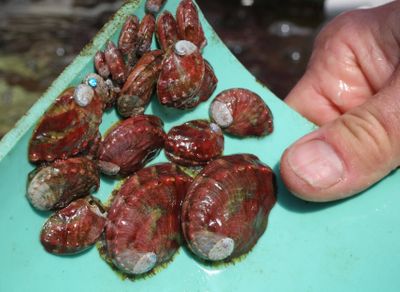Abalone are being loved to brink of extinction

SEATTLE – The authorities popped him near the docks in Port Angeles.
On a March afternoon in 1994, a sleek fishing boat – not-so-subtly named the Abalone Made – came ashore after puttering around Freshwater Bay. The waiting cops nabbed the captain and seized his contraband: 188 specimens of a rare Puget Sound mollusk, the pinto abalone, a strange, fist-sized snail stuffed in algae-encrusted shells.
The thief would confess he’d been stealing the tasty seafood delicacies by the tens of thousands – enough to pay off his 26-foot commercial diving boat and buy a new Jeep Cherokee. The real damage wouldn’t be known until much later.
At the time, Puget Sound’s lone abalone species was already hurtling toward extinction. More than with any other creature in these waters, illicit harvesting may have pushed it over the edge.
Today, so few of the shellfish remain that scientists armed with kitchen utensils and model-train glue are trying to mate survivors in a lab. They plan this summer to transplant the creatures’ offspring in the Strait of Juan de Fuca and hope that will jump-start a population nearing collapse. Similar efforts are under way in British Columbia, but it’s too soon to know if the attempts will succeed.
Abalone are ecosystem engineers and voracious grazers. They cruise at night, scraping algae off rocks with a scaly tongue and feeding on drifting kelp. They keep rocky patches clean for other creatures to colonize.
Their ability to wander is key to their survival.
The broadcast spawners mate by releasing sperm and eggs in the water, which mix and produce young only if parents are close together. So abalone travel, rarely more than a few dozen meters, congregating on outcroppings to spawn at low tides. There, people for centuries have collected them for food and treasure.
Connoisseurs pound the meat with mallets, boil it in soup with cabbage, stir-fry it with pepper and garlic or serve it as steak stuffed with prosciutto and pine nuts. The underside of an abalone’s scraggly shell holds swirling iridescent patterns that change color with the light. Polished pieces of shell become saxophone keys, pocketknife handles and guitar inlays. Jewelers shape them into pendants for earrings, necklaces and bracelets.
Such popularity led to boom-and-bust commercial fishing in California for white, black, green and pink abalone. The same pattern followed along the Strait of Georgia, north of the San Juan Islands. Washington never allowed commercial fishing, but by the late 1980s sport fishermen saw fewer and fewer of the creatures. In 1994 the state halted abalone collecting for good.
In the 15 years since, pinto abalone populations at surveyed sites in Washington have declined more than 80 percent.
From Admiralty Inlet to the Pacific, abalone once were so common that San Juan residents called retreating currents “abalone tides.” Today, the creatures probably number in the tens of thousands, perhaps even a few hundred thousand. That’s a pittance after decades when sport fishermen – allowed to collect a handful of the creatures each – gathered a combined total of more than 40,000 a year.
To understand the decline, scientists tested water temperature and salt content, but found few clues. They knew the return of sea otters – furry abalone lovers – may have played a role near the coast.
But in and around Port Angeles and the San Juans, biologists tended to blame continued poaching. Certainly, history suggested as much.
The fisherman police caught in 1994 admitted regularly stealing clustering abalone when he dove legally for cucumbers and urchins. He sold the marine snails to local restaurants for $5 to $10 or less apiece. The restaurants resold them for as much as $25. Some even found their way overseas.
Biologists calculated that this thief took as much by himself as all other recreational fishermen combined in some years. And no one believed he was the region’s only poacher. “I still hear people whisper about knowing where they can find illegal abalone,” said Joth Davis, a biologist with Taylor Shellfish.
But the more biologists dove along the Strait of Juan de Fuca, the more confused they grew. Thirty years ago, one-fifth of abalone were small. Today only 2 percent are. Average abalone shell sizes have grown larger. “We thought, ‘Wouldn’t poachers want the biggest ones?’ ” said Don Rothaus, a Fish and Wildlife biologist.
Then they hit upon an obvious answer: The creatures were getting old but not reproducing. The same peculiar biological tic that made abalone easy prey for thieves also, in the end, appeared to be their downfall.
Poachers weren’t taking more because abalone no longer clustered in quantities big enough to make it worth their while.
So many abalone had been removed from Puget Sound that those remaining lived too far apart to congregate. They couldn’t get close enough to mate.
Along Hood Canal at a new small shellfish nursery in Port Gamble, Jason Suzuki lifted the lid on a narrow tub to show off his babies. Inside, dozens of colorful abalone the size of poker chips were strewed about like pebbles, munching on a cocktail of algae perfected by Suzuki.
“They’re looking good,” he said. “They look happy.”
After scientists help adults spawn in Mukilteo, the offspring swim free for about two weeks. Then they are brought here, where Suzuki monitors their growth.
In late summer, about 3,000 of them will travel by boat to the San Juan Islands, where biologists will gently plant them in the seafloor.
Then they will wait and watch for the next abalone tide.